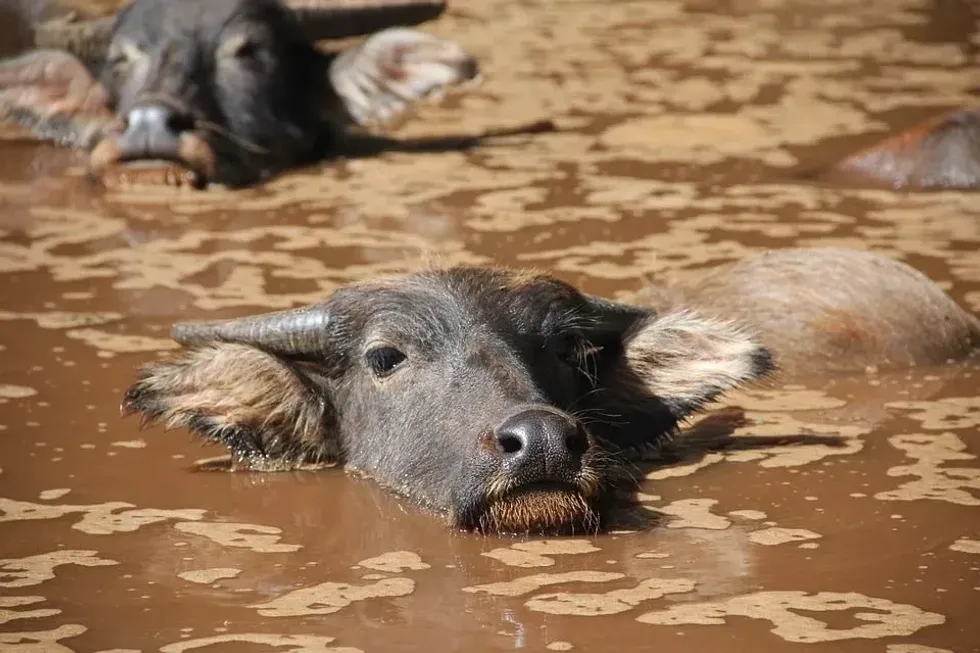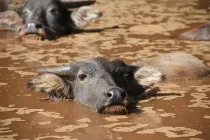The water buffalo, also known as the domesticated water buffalo or the Asian water buffalo, originates from India, China, and Southeast Asia.
In the present day, these water buffalos can be found across Australia, Europe, North and South America, and Africa.
There are two different types of water buffalos which are categorized based on behavioral and other criteria: the river buffalo, which is mainly found in India, and towards the Balkans, Italy, and Egypt, and the swamp buffalo, which ranges from Assam to China, and is found throughout South Asia.
The wild water buffalo (Bubalus arnee) is known to be the domestic water buffalo's ancestor. The river water buffalo is believed to have originated in the India-Nepal region and was domesticated approximately 5,000 years ago.
In comparison, the swamp buffalo is believed to have originated in China and was domesticated around 4,000 years ago. The population of the swamp buffalo then spread throughout Southeast Asia and made its way up to the Yangtze valley about 3,000 years ago.
If you like reading these Bubalus bubalis and Bubalus arnee facts, you can check out our facts on the buffalo or the plains zebra too.
Water Buffalo Interesting Facts
What type of animal is a water buffalo?
A water buffalo is a massive herbivorous animal from the family Bovidae.
What class of animal does a water buffalo belong to?
The water buffalo belongs to the class Mammalia.
How many water buffalos are there in the world?
There are 208,098,759 water buffaloes in the world distributed across five continents.
Where does a water buffalo live?
Water buffaloes live in tropical and subtropical forests. They also live in wet grasslands. As these are terrestrial animals, they are dependent on a source of water just like any other animal. They are also likely to be found in rivers of mud.
What is a water buffalo's habitat?
The habitat of water buffalo animals could be a swamp, river, or pond. Water buffalo hooves prevent the animal from sinking deep down into the mud in these ponds and rivers.
Who do water buffalos live with?
These animals live in groups known as herds. When first born, young water buffalos stick tightly to their mothers and live with them for the first few years of their life.
Male water buffalos go on to leave the herd that they were born in and join other herds (that consist only of males), whereas female water buffalos tend to stay with their mothers in the same herd.
How long does a water buffalo live?
The lifespan of this animal is 25 years. Water buffalos live for 25 years, but the African water buffalo has a lifespan of about 26 years.
How do they reproduce?
Water buffalo tend to have an estrus period of about 24 hours. Females can mate with males at this time, leading to conceiving and then giving birth to a calf after carrying them for nine to 11 months
What is their conservation status?
Water buffalos have been domesticated and commercialized for a long time. These animals have been used to produce water buffalo milk, water buffalo meat, water buffalo leather, water buffalo horns, and more! Their conservation status is currently Not Extinct. This shows that whilst they are not extinct yet, they are at risk of this.
Water Buffalo Fun Facts
What do water buffalos look like?
Water buffalos have a gray-black coat and males of this species have crescent-shaped horns that curve backward. The average water buffalo horn stretches to 5 ft (152.4 cm) long and has ridges on its surface.
Females are smaller when compared to males in size and weight. Females also have horns, but again, they are smaller than the horns of males.
How cute are they?
The calves of these animals are particularly cute, especially as they have such big eyes. Adults can be cute as well but their large size can make them look intimidating to some people.
How do they communicate?
Water buffalos use low grunt sounds when they are communicating with each other. Domestic water buffalo animals often use these grunts to ask for food and water!
How big is a water buffalo?
The average height of water buffalos is 94–118 in (240–300 cm). They can be really heavyweight, weighing 660–1,210 lb (300–550 kg). This species has a slightly longer tail than a bison (whose tail is up to 26 in (66.04 cm) long) as its tall is 33 inches (83.82 cm) long.
How fast can a water buffalo run?
Domestic water buffalo are usually calm animals. Despite this, they can still run quite fast. When it comes to wild water buffalo, they face many threats in the wild so they are more aggressive than domestic water buffalo are and can run really fast too. They can reach a top speed of 30 mph (48.3 kph) when they're threatened.
How much does a water buffalo weigh?
Known as the largest bovid, water buffalo animals can weigh from 660–1,210 lb (300–550 kg). They grow up to 94–118 in (240–300 cm) tall. Males are between 51–52 in (129–133 cm) long from their head to their back and females are 47–50 in (120–127 cm) long.
What are their male and female names of the species?
The species is known as Bubalus bubalis and there are no specific names for males or females.
What would you call a baby water buffalo?
The young babies of this animal are called calves. Usually, a female gives birth to one calf at a time after carrying the calf for nine to 11 months.
For about three years after birth, the calf stays with its mother. After three years, males leave the original herd and move to another herd where other male buffalos are present, whereas female calves stay with the original herd, along with their mother. Females generally conceive every other year.
What do they eat?
As this species is herbivorous, they are seen eating vegetation only. Water buffalos love to eat aquatic plants as they love to be in the water and both Asian buffalo and African buffalo animals can eat trees and shrubs when they can't find enough herbs or grass to eat.
Are they dangerous?
These animals are not usually violent towards humans but all species of water buffalo can be potentially dangerous and are incredibly strong. Due to their large size and their ability to run fast, it is important that humans do not provoke them.
The Cape buffalo, however, is arguable the most dangerous buffalo. It is found in Africa and is known to kill almost 200 people each year.
Would they make a good pet?
These animals cannot be good pets but they can be great farm animals. There are so many domesticated water buffalo, showing that they can be a great part of farm life. If a farm owner does wish to own a domestic water buffalo they must provide a lot of water for them to wallow and swim in.
Did you know...
One of the best Asian water buffalo facts is that the horns of the male water buffalo curve backward and can have a length of 5 ft(1.5 m). A female water buffalo is likely to have smaller horns than a male!
One of the best water buffalo facts for kids is that when it's time to travel, the African water buffalo species uses its own form of democracy! The herd stands in a group and turns in the direction where they would like to go to.
The direction in which the majority of the animal population turns, wins. Then, the female head leads the herd in the winning direction.
African water buffalos are known to attack humans and they can be really aggressive. Also, they are very protective of their herd. If any members of the herd get sick or old, they take care of them and protect them from predators.
Water buffalos not only walk through water, but they actually spend a lot of time completely submerged under the water! This is where they get their name, 'water buffalo', from.
A water buffalo can also be described colloquially as a cow.
What is the difference between a water buffalo and a buffalo?
There are many differences between a buffalo and a water buffalo. The main difference is in how their bodies are adapted to the habitats that they live in.
The water buffalo population spends a lot of time in water and other buffalos don't, so this means that they have different foot structures. A water buffalo has a wide-splayed hoof that helps them to travel through the softer ground surrounding rivers and swamps with ease.
Water buffalo derived products
There are many products that are derived from water buffalos. For example, river water buffalo milk has proteins and fatty acids in a high quantity so it is very popular.
The milk from these animals can be used in making a variety of dairy products. This includes cream, butter, and ghee.
Along with these, some other products that can be derived from water buffalo milking are fermented milk products like yogurt, hard cheese, soft cheese, and more. Water buffalo milk is not always easy to find but it can normally be bought online or in farm shops.
Here at Kidadl, we have carefully created lots of interesting family-friendly animal facts for everyone to discover! Learn more about some other mammals including the zebra, or plains zebra.
You can even occupy yourself at home by drawing one on our buffalo coloring pages.










